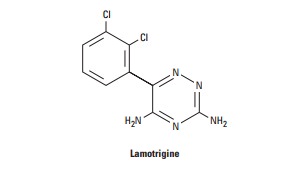Chapter: Basic & Clinical Pharmacology : Antiseizure Drugs
Lamotrigine
LAMOTRIGINE
Lamotrigine
was developed when some investigators thought that the antifolate effects of
certain antiseizure drugs (eg, phenytoin) might contribute to their
effectiveness. Several phenyltriazines were developed, and though their
antifolate properties were weak, some were active in seizure screening tests.

Mechanism of Action
Lamotrigine,
like phenytoin, suppresses sustained rapid firing of neurons and produces a
voltage- and use-dependent blockade of Na+ channels. This action
probably explains lamotrigine’s efficacy in focal epilepsy. It appears likely
that lamotrigine also inhibits voltage-gated Ca2+ channels,
particularly the N- and P/Q-type channels, which would account for its efficacy
in primary general-ized seizures in childhood, including absence attacks.
Lamotrigine also decreases the synaptic release of glutamate.
Clinical Uses
Although
most controlled studies have evaluated lamotrigine as add-on therapy, it is
generally agreed that the drug is effective as monotherapy for partial
seizures, and lamotrigine is now widely prescribed for this indication. The
drug is also active against absence and myoclonic seizures in children and is
approved for seizure con-trol in the Lennox-Gastaut syndrome. Lamotrigine is
also effective for bipolar disorder. Adverse effects include dizziness,
headache, diplopia, nausea, somnolence, and skin rash. The rash is considered a
typical hypersensitivity reaction. Although the risk of rash may be diminished
by introducing the drug slowly, pediatric patients are at greatest risk, some
studies suggest that a potentially life-threatening dermatitis will develop in
1–2% of pediatric patients.
Pharmacokinetics
Lamotrigine
is almost completely absorbed and has a volume of distribution in the range of
1–1.4 L/kg. Protein binding is only about 55%. The drug has linear kinetics and
is metabolized pri-marily by glucuronidation to the 2-N-glucuronide, which is excreted in the urine. Lamotrigine has a
half-life of approximately 24 hours in normal volunteers; this decreases to
13–15 hours in patients taking enzyme-inducing drugs. Lamotrigine is effective
against partial seizures in adults at dosages typically between 100 and 300
mg/d and with a therapeutic blood level near 3 mcg/mL. Valproate causes a
twofold increase in the drug’s half-life; in patients receiving valproate, the
initial dosage of lamotrigine must be reduced to 25 mg every other day.
Related Topics